Assessing the Effects on Health Inequalities of Differential Exposure and Differential Susceptibility of Air Pollution and Environmental Noise in Barcelona, 2007–2014
Abstract
1. Introduction
2. Materials and Methods
2.1. Data Setting
2.2. Variables and Information Sources
2.2.1. Response Variables
2.2.2. Socioeconomic Indicators
2.2.3. Air Pollution and Environmental Noise Exposure
2.3. Statistical Analysis
2.4. Mutual Standardization Problem
2.5. Spatio-Temporal Adjustment
2.6. Addressing the Misalignment Problem
2.7. Assessing the Exposure and Susceptibility Differentials
3. Results
4. Discussion
5. Conclusions
Author Contributions
Funding
Acknowledgments
Conflicts of Interest
Abbreviations
| (A) | A-weighted |
| db | Decibels |
| CO | Carbon monoxide |
| GAM | Generalized Additive Models |
| IDESCAT | Statistical Institute of Catalonia |
| INLA | Integrated Nested Laplace Approximation |
| MCMC | Markov Chain Monte Carlo |
| NO2 | Nitrogen dioxide |
| PC-priors | Penalising complexity priors |
| PM2.5 | 2.5 micrometres diameter particulate matter |
| PM10 | 10 micrometres diameter particulate matter |
| SO2 | Sulphur dioxide |
| SPDE | Stochastic partial differential equations |
| UNPD | United Nations Development Programme |
| WHO | World Health Organisation |
| XVPCA | Catalan Atmospheric Pollution Surveillance and Control Network |
Appendix A
Key Messages
References
- Bouchard, L.; Albertini, M.; Batista, R.; de Montigny, J. Research on health inequalities: A bibliometric analysis (1966–2014). Soc. Sci. Med. 2015, 141, 100–108. [Google Scholar] [CrossRef]
- Black, D. Health Inequalities. Report of a Research Working Group; Department of Health and Social Security: London, UK, 1980. [Google Scholar]
- Acheson, D. Independent Inquiry into Inequalities in Health Report; The Stationary Office: London, UK, 1998. Available online: https://www.gov.uk/government/uploads/system/uploads/attachment_data/file/265503/ih.pdf (accessed on 3 August 2019).
- Marmot, M. Social determinants of health inequalities. Lancet 2005, 365, 1099–1104. [Google Scholar] [CrossRef]
- Kunst, A.E. Describing socioeconomic inequalities in health in European countries: An overview of recent studies. Rev. D’epidemiol. Sante Publ. 2007, 55, 3–11. [Google Scholar] [CrossRef]
- Mackenbach, J.P.; Stirbu, I.; Roskam, A.J.; Schaap, M.M.; Menvielle, G.; Leinsalu, M.; Kunst, A.E. Socioeconomic inequalities in health in 22 European countries. N. Engl. J. Med. 2008, 358, 2468–2481. [Google Scholar] [CrossRef]
- Deguen, S.; Zmirou-Navier, D. Social inequalities resulting from health risks related to ambient air quality—A European review. Eur. J. Public Health 2010, 28, 27–35. [Google Scholar] [CrossRef]
- Bowen, W. An analytical review of environmental justice research: What do we really know? Environ. Manag. 2002, 29, 3–15. [Google Scholar] [CrossRef]
- Evans, G.W.; Kantrowitz, E. Socioeconomic status and health: The potential role of environmental risk exposure. Annu. Rev. Public Health 2002, 23, 303–331. [Google Scholar] [CrossRef]
- Brulle, R.J.; Pellow, D.N. Environmental justice: Human health and environmental inequalities. Annu. Rev. Public Health 2006, 27, 103–124. [Google Scholar] [CrossRef]
- Laurent, O.; Bard, D.; Filleul, L.; Segala, C. Effect of socioeconomic status on the relationship between atmospheric pollution and mortality. J. Epidemiol. Community Health 2007, 61, 665–675. [Google Scholar] [CrossRef]
- Hajat, A.; Hsia, C.; O’Neill, M.S. Socioeconomic disparities and air pollution exposure: A global review. Curr. Environ. Health Rep. 2015, 2, 440–450. [Google Scholar] [CrossRef]
- Schlosberg, D. Defining Environmental Justice: Theories, Movements, and Nature; Oxford University Press: Oxford, UK, 2007. [Google Scholar]
- Miller, G.T. Environmental Science: Working With the Earth, 9th ed.; Brooks/Cole: Pacific Grove, CA, USA, 2003. [Google Scholar]
- Laurent, E. Issues in environmental justice within the European Union. Ecol. Econ. 2011, 70, 1846–1853. [Google Scholar] [CrossRef]
- Steger, T.; Filcak, R. Ghettos in Slovakia. Confronting Roma Social and Enviromental Exclusion. Anal. Krit. 2014, 36, 229–250. [Google Scholar]
- Naqvi, Z.; Zwickl, K. Fifty shades of green: Revisiting decoupling by economic sectors and air pollutants. Ecol. Econ. 2017, 133, 111–126. [Google Scholar] [CrossRef]
- Steger, T.; Filcak, R.; Harper, K. Environmental Justice in Central and Eastern Europe: Mobilization, Stagnation, and Detraction. In The Routledge Handbook of Environmental Justice; Routledge: London, UK, 2018; pp. 641–652. Available online: http://epub.wu.ac.at/4420/1/EcolEcon_WorkingPaper_2015_1.pdf (accessed on 4 September 2019).
- Glatter-Götz, H.; Mohai, P.; Haas, W.; Plutzar, C. Environmental inequality in Austria: Do inhabitants’socioeconomic characteristics differ depending on their proximity to industrial polluters? Environ. Res. Lett. 2019, 14, 074007. [Google Scholar] [CrossRef]
- O’Neill, M.S.; McMichael, A.J.; Schwartz, J.; Wartenberg, D. Poverty, environment, and health: The role of environmental epidemiology and environmental epidemiologists. Epidemiology 2007, 18, 664–668. [Google Scholar] [CrossRef]
- Kawachi, I.; Berkman, L.F. (Eds.) Neighbourhoods and Health; Oxford University Press: New York, NY, USA, 2003. [Google Scholar]
- Mackenbach, J.P.; Kulhánova, I.; Menvielle, G.; Bopp, M.; Borrell, C.; Costa, G.; Deboosere, P.; Esnaola, S.; Kalediene, R.; Kovacs, K.; et al. Trends in inequalities in premature mortality: A study of 3.2 million deaths in 13 European countries. J. Epidemiol. Community Health 2015, 69, 207–217. [Google Scholar] [CrossRef]
- Marí-Dell’olmo, M.; Gotsens, M.; Palència, L.; Rodríguez-Sanz, M.; Martinez-Beneito, M.A.; Ballesta, M.; Calvo, M.; Cirera, L.; Daponte, A.; Domínguez-Berjón, F.; et al. Trends in socioeconomic inequalities in mortality in small areas of 33 Spanish cities. BMC Public Health 2016, 16, 663. [Google Scholar] [CrossRef]
- Díaz, J.; López, C.; Tobías, A.; Linares, C. The risks of living loud. Results of a European study. Rev. Interdiscipl. Gestión Ambiental 2003, 58, 23–32. (In Spanish) [Google Scholar]
- Schwela, D.; Kephalopoulos, S.; Prasher, D. Confounding or aggravating factors in noise-induced health effects: Air pollutants and other stressors. Noise Health 2005, 7, 41–50. [Google Scholar] [CrossRef]
- Beelen, R.; Hoek, G.; Houthuijs, D.; van den Brandt, P.A.; Goldbohm, R.A.; Fischer, P.; Schouten, L.J.; Armstrong, B.; Brunekreef, B. The joint association of air pollution and noise from road traffic with cardiovascular mortality in a cohort study. Occup. Environ. Med. 2009, 66, 243–250. [Google Scholar] [CrossRef]
- Foraster, M.; Künzli, N.; Aguilera, I.; Rivera, M.; Agis, D.; Vila, J.; Bouso, L.; Deltell, A.; Marrugat, J.; Ramos, R.; et al. High blood pressure and long-term exposure to indoor noise and air pollution from road traffic. Environ. Health Perspect. 2014, 122, 1193–1200. [Google Scholar] [CrossRef]
- Ising, H.; Braun, C. Acute and chronic endocrine effects of noise: Review of the research conducted at the institute for water, soil and air hygiene. Noise Health 2000, 2, 7–24. [Google Scholar]
- Niemann, H.; Bonnefoy, X.; Braubach, M.; Hecht, K.; Maschke, C.; Rodrigues, C.; Röbbel, N. Noise-induced annoyance and morbidity results from the pan-European LARES study. Noise Health 2006, 8, 63–79. [Google Scholar] [CrossRef]
- Sørensen, M.; Lühdorf, P.; Ketzel, M.; Andersen, Z.J.; Tjønneland, A.; Overvad, K.; Raaschou-Nielsen, O. Combined effects of road traffic noise and ambient air pollution in relation to risk for stroke? Environ. Res. 2014, 133, 49–55. [Google Scholar] [CrossRef]
- Fairburn, F.; Braubach, M. Social inequalities in environmental risks associated with housing and residential location. In Environment and Health Risks: A Review of the Influence and Effects of Social Inequalities; World Health Organization, Regional Office for Europe: Copenhagen, Denmark, 2010; pp. 33–75. Available online: http://www.euro.who.int/en/health-topics/health-determinants/gender/publications/2010/environment-and-health-risks-a-review-of-the-influence-and-effects-of-social-inequalities (accessed on 3 August 2019).
- Goodman, A.; Wilkinson, P.; Stafford, M.; Tonne, C. Characterising socio-economic inequalities in exposure to air pollution: A comparison of socio-economic markers and scales of measurement. Health Place 2011, 17, 767–774. [Google Scholar] [CrossRef]
- Richardson, E.A.; Pearce, J.; Tunstall, H.; Mitchell, R.; Shortt, N.K. Particulate air pollution and health inequalities: A Europe-wide ecological analysis. Int. J. Health Geogr. 2013, 12, 34. [Google Scholar] [CrossRef]
- Kruize, H.; Bowman, A.A. Environmental (In)equity in the Netherlands. A Case Study in the Distribution of Environmental Quality in the Rijnmond Region; RIVM Report 50012003/2004; 2004; Available online: http://www.pbl.nl/sites/default/files/cms/publicaties/550012003.pdf (accessed on 3 August 2019).
- Kohlhuber, M.; Mielck, A.; Weiland, S.K.; Bolte, G. Social inequality in perceived environmental exposures in relation to housing in Germany. Environ. Res. 2006, 101, 246–255. [Google Scholar] [CrossRef]
- Bolte, G.; Tamburlini, G.; Kohlhuber, M. Environmental inequalities among children in Europe—Evaluation of scientific evidence and policy implications. Eur. J. Public Health 2009, 28, 14–20. [Google Scholar] [CrossRef]
- Bocquier, A.; Cortaredona, S.; Boutin, C.; David, A.; Bigot, A.; Chaix, B.; Gaudart, J.; Verger, P. Small-area analysis of social inequalities in residential exposure to road traffic noise in Marseilles, France. Eur. J. Public Health 2013, 23, 540–546. [Google Scholar] [CrossRef]
- Dale, L.M.; Goudreau, S.; Perron, S.; Ragettli, M.S.; Hatzopoulou, M.; Smargiassi, A. Socioeconomic status and environmental noise exposure in Montreal, Canada. BMC Public Health 2015, 15, 205. [Google Scholar] [CrossRef]
- Cano-Serral, G.; Azlor, E.; Rodríguez-Sanz, M.; Pasarín, M.I.; Martínez, J.M.; Puigpinós, R.; Muntaner, C.; Borrell, C. Socioeconomic inequalities in mortality in Barcelona: A study based on census tract (MEDEA project). Health Place 2009, 15, 186–192. [Google Scholar] [CrossRef]
- Borrell, C.; Marí-Dell’olmo, M.; Cano-Serral, G.; Martínez-Beneito, M.A.; Gotxens, M.; MEDEA Members. Inequalities in mortality in small areas of eleven Spanish cities (the multicentre MEDEA project). Health Place 2010, 16, 703–771. [Google Scholar] [CrossRef]
- Borrell, C.; Marí-Dell’olmo, M.; Palència, L.; Gotsens, M.; Burström, B.O.; Domínguez-Berjón, F.; Rodríguez-Sanz, M.; Dzúrová, D.; Gandarillas, A.; Hoffmann, R.; et al. Socioeconomic inequalities in mortality in 16 European cities. Scand. J. Public Health. 2014, 42, 245–254. [Google Scholar] [CrossRef]
- Hoffmann, R.; Borsboom, G.; Saez, M.; Marí Dell’olmo, M.; Burström, B.; Corman, D.; Costa, C.; Deboosere, P.; Domínguez-Berjón, M.F.; Dzúrová, D.; et al. Social differences in avoidable mortality between small areas of 15 European cities: An ecological study. Int. J. Health Geogr. 2014, 13, 8. [Google Scholar] [CrossRef]
- Nolasco, A.; Moncho, J.; Quesada, J.A.; Melchor, I.; Pereyra-Zamora, P.; Tamayo-Fonseca, N.; Martínez-Beneito, M.A.; Zurriaga, O.; Ballesta, M.; Daponte, A.; et al. Trends in socioeconomic inequalities in preventable mortality in urban areas of 33 Spanish cities. Int. J. Equity Health 2015, 14, 33. [Google Scholar] [CrossRef]
- Marí-Dell’olmo, M.; Gotsens, M.; Palència, L.; Burström, B.; Corman, D.; Costa, G.; Deboosere, P.; Díez, È.; Domínguez-Berjón, F.; Dzúrová, D.; et al. Socioeconomic inequalities in cause-specific mortality in 15 European cities. J. Epidemiol. Community Health 2015, 69, 432–441. [Google Scholar] [CrossRef]
- Gelfand, A.E. Misaligned spatial data: The change of support problem. In Handbook of Spatial Statistics; Gelfand, A.E., Diggle, P.J., Fuentes, M., Guttorp, P., Eds.; Taylor & Francis: Boca Raton, FL, USA, 2010. [Google Scholar]
- Gotway, C.; Young, L. Combining incompatible spatial data. J. Am. Stat. Assoc. 2002, 97, 632–648. [Google Scholar] [CrossRef]
- Barceló, M.A.; Varga, D.; Tobias, A.; Díaz, J.; Linares, C.; Saez, M. Long term effects of traffic noise on mortality in the city of Barcelona, 2004–2007. Environ. Res. 2016, 147, 193–206. [Google Scholar] [CrossRef]
- Ingebrigtsen, R.; Steinsland, I.; Cirera, L.L.; Saez, M. Spatially misaligned data and the impact of monitoring network on health effect estimates. In Bayesian Spatial Modelling of Non-Stationary Processes and Misaligned Data Utilising Markov Properties for Computational Efficiency; Doctoral theses at NTNU, 2015:62; Ingebrigtsen, R., Ed.; Norwegian University of Science and Technology: Trondheim, Norway, 2015. [Google Scholar]
- Lawson, A.B.; Browne, W.J.; Vidal-Rodeiro, C.L. Disease Mapping with WinBUGS and MLwiN; John Wiley & Sons: Chichester, UK, 2003. [Google Scholar]
- Barceló, M.A.; Saez, M.; Saurina, C. Spatial variability in mortality inequalities, socioeconomic deprivation, and air pollution in small areas of the Barcelona Metropolitan Region, Spain. Sci. Total Environ. 2009, 407, 5501–5523. [Google Scholar] [CrossRef]
- Greene, W.H. Econometric Analysis, 5th ed.; Pearson Education: Upper Saddle River, NJ, USA, 2003; pp. 191–201. [Google Scholar]
- IDESCAT. Available online: http://www.idescat.cat (accessed on 3 August 2019).
- Barcelona City Council. Territorial Division (in Catalan). Available online: https://www.bcn.cat/estadistica/catala/terri/index.htm (accessed on 16 September 2019).
- OpenDataBCN. Open Data Service of the City of Barcelona. Available online: http://opendata.bcn.cat/opendata/en/cataleg/ (accessed on 3 August 2019).
- Nel·lo, O. The five challenges of urban rehabilitation. The Catalan experience. Urban Res. Pract. 2011, 4, 308–325. [Google Scholar] [CrossRef]
- Nel·lo, O.; Blanco, I. The Urban Segregation in the Metropolitan Region of Barcelona. Document de Treball del Pla Estratègic Metropolità de Barcelona 2030. 2015. Available online: https://pemb.cat/es/publicaciones/la_segregacion_urbana_en_la_region_metropolitana_de_barcelona/41/ (accessed on 27 August 2019). (In Catalan).
- Sánchez-Castro, N. Evolution of Spatial Segregation in Barcelona (2007–2013). Analysis and Urban Policies. Trabajo Fin de Master, Master en Sostenibilidad, Universidad Politécnica de Catalunya, Barcelona, 2014. Available online: https://upcommons.upc.edu/handle/2117/77896 (accessed on 27 August 2019). (In Spanish).
- Calvo, M.J.; Güell, X.; Salabert, J. Territorial Distribution of Income Per Capita in Barcelona; Ajuntament de Barcelona: Barcelona, Spain, 2007. (In Spanish) [Google Scholar]
- United Nations Development Programme. Human Development Index and Its Components. Available online: http://hdr.undp.org/en/composite/HDI (accessed on 3 August 2019).
- Malmusi, D.; Borrell, C.; Benach, J. Migration-related health inequalities: Showing the complex interactions between gender, social class and place of origin. Soc. Sci. Med. 2010, 71, 1610–1619. [Google Scholar] [CrossRef]
- Idealista. Available online: https://www.idealista.com (accessed on 3 March 2017). (In Spanish).
- Department of Territory and Sustainability. Catalan Government. Geoinformation. Air Quality Data. 2016. Available online: http://mediambient.gencat.cat/ca/05_ambits_dactuacio/atmosfera/qualitat_de_laire/vols-saber-que-respires/ (accessed on 3 August 2019). (In Catalan).
- Department of Territory and Sustainability. Catalan Government. Strategic Maps of Agglomerations—2nd Phase. 2016. Available online: http://mediambient.gencat.cat/ca/05_ambits_dactuacio/atmosfera/contaminacio_acustica/gestio_ambiental_del_soroll/mapes_de_soroll/mapes_estrategics_de_soroll/mapes_estrategics_d_aglomeracions/mapes_estrategics_aglomeracions_2a_fase/ (accessed on 3 August 2019). (In Catalan).
- Department of Territory and Sustainability. Catalan Government. Technical Memory. Strategic Noise Map. Barcelonès I. 2016. Available online: http://mediambient.gencat.cat/web/.content/home/ambits_dactuacio/atmosfera/contaminacio_acustica/gestio_ambiental_del_soroll/mapes_de_soroll/mapes_estrategics_de_soroll/mapes_d_aglomeracions/memories/mes_bcn_i.pdf (accessed on 3 August 2019). (In Catalan).
- Rosenbaum, P.; Rubin, D. Difficulties with regression analyses of age-adjusted rates. Biometrics 1984, 40, 437–443. [Google Scholar] [CrossRef]
- Renart, G.; Saez, M.; Saurina, C.; Marcos-Gragera, R.; Ocaña-Riola, R.; Martos, C.; Barceló, M.A.; Arribas, F.; Alcalá, T. A common error in the ecological regression of cancer incidence on the deprivation index. Rev. Panam. Salud Pública 2013, 34, 83–91. [Google Scholar]
- Lindgren, F.; Rue, H.; Lindström, J. An explicit link between Gaussian fields and Gaussian Markov random fields: The stochastic partial differential equation approach (with discussion). J. R. Stat. Soc. Ser. B Stat. Methodol. 2011, 73, 423–498. [Google Scholar] [CrossRef]
- R INLA Project 2019. Random Walk of Order 1 (RW1). Available online: http://www.r-inla.org/models/latent-models (accessed on 3 August 2019).
- Krainski, E.T.; Gómez-Rubio, V.; Bakka, H.; Lenzi, A.; Castro-Camilo, D.; Simpson, D.; Lindgren, F.; Rue, H. Advanced Spatial Modelling with Stochastic Partial Differential Equations Using R and INLA; CRC Press, Taylor & Francis Group: Boca Raton, FL, USA, 2019. [Google Scholar]
- Rue, H.; Martino, S.; Chopin, N. Approximate Bayesian inference for latent Gaussian models by using integrated nested Laplace approximations (with discussion). J. R. Stat. Soc. Ser. B Stat. Methodol. 2009, 71, 319–392. [Google Scholar] [CrossRef]
- Blangiardo, M.; Cameletti, M.; Baio, G.; Rue, H. Spatial and spatio-temporal models with R-INLA. Spat. Spatio-temporal Epidemiol. 2013, 4, 33–49. [Google Scholar] [CrossRef]
- Simpson, D.P.; Rue, H.; Martins, T.G.; Riebler, A.; Sørbye, S.H. Penalising model component complexity: A principled, practical approach to constructing priors (with discussion). Stat. Sci. 2017, 32, 46. Available online: https://repository.kaust.edu.sa/bitstream/handle/10754/623413/euclid.ss.1491465621.pdf?sequence=1 (accessed on 3 August 2019). [CrossRef]
- Wood, S.N. On p-values for smooth components of an extended generalized additive model. Biometrika 2013, 100, 221–228. [Google Scholar] [CrossRef]
- Kunkel, S.R.; Atchley, R.C. Why gender matters: Being female is not the same as not being male. Am. J. Prev. Med. 1996, 12, 294–296. [Google Scholar] [CrossRef]
- R Core Team. R: A Language and Environment for Statistical Computing; R Foundation for Statistical Computing: Vienna, Austria, 2019; Available online: https://www.R-project.org/ (accessed on 3 August 2019).
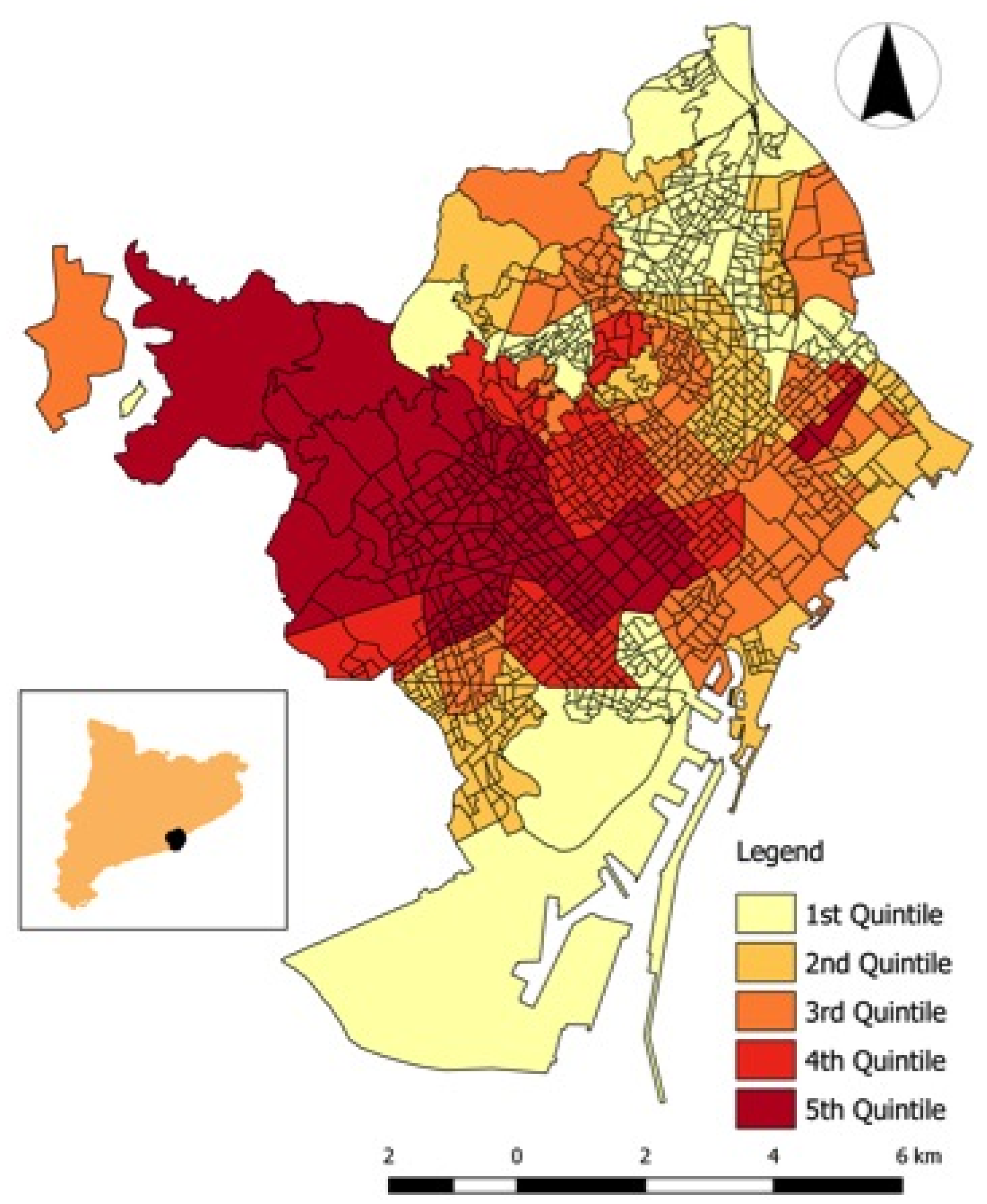
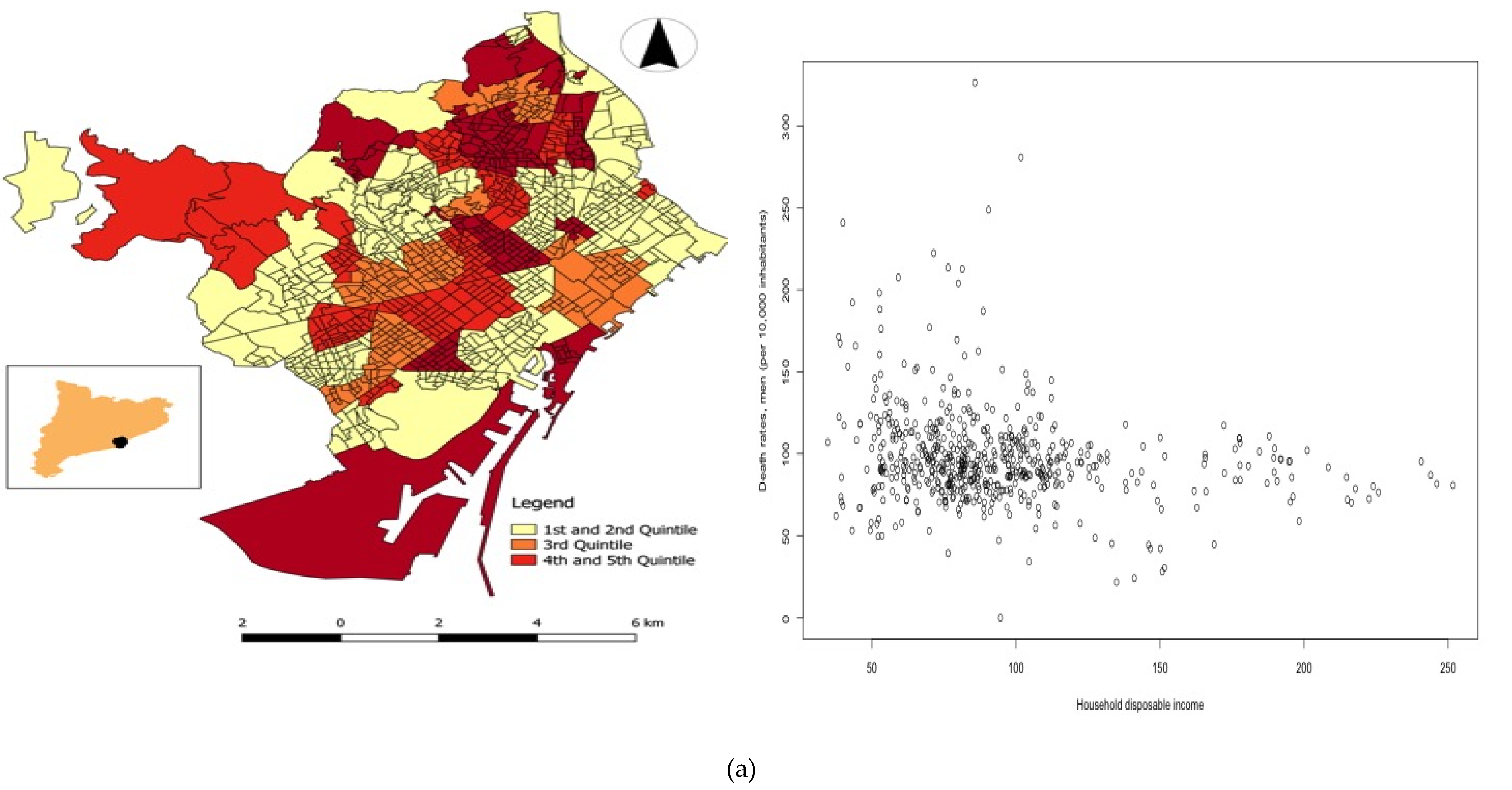
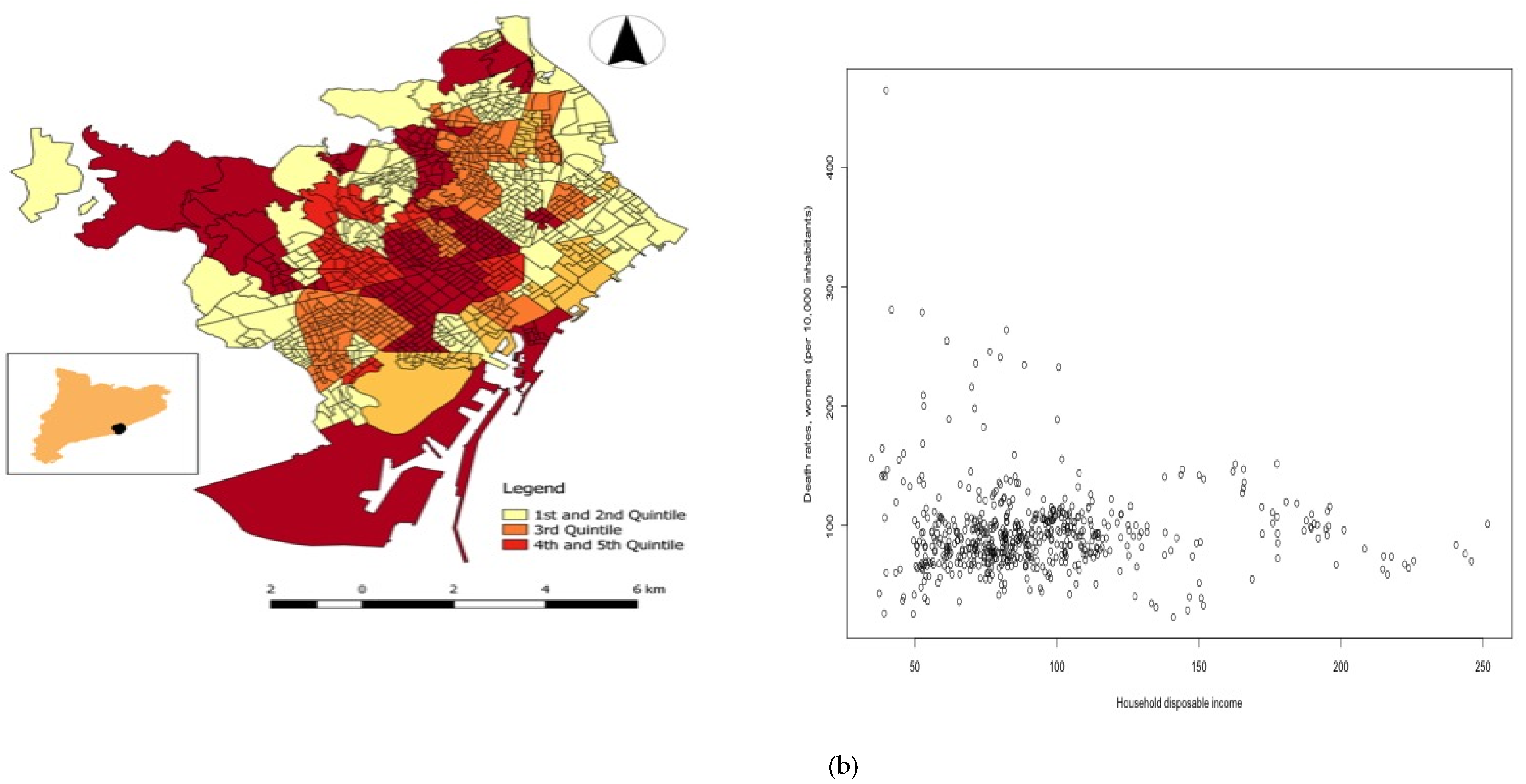
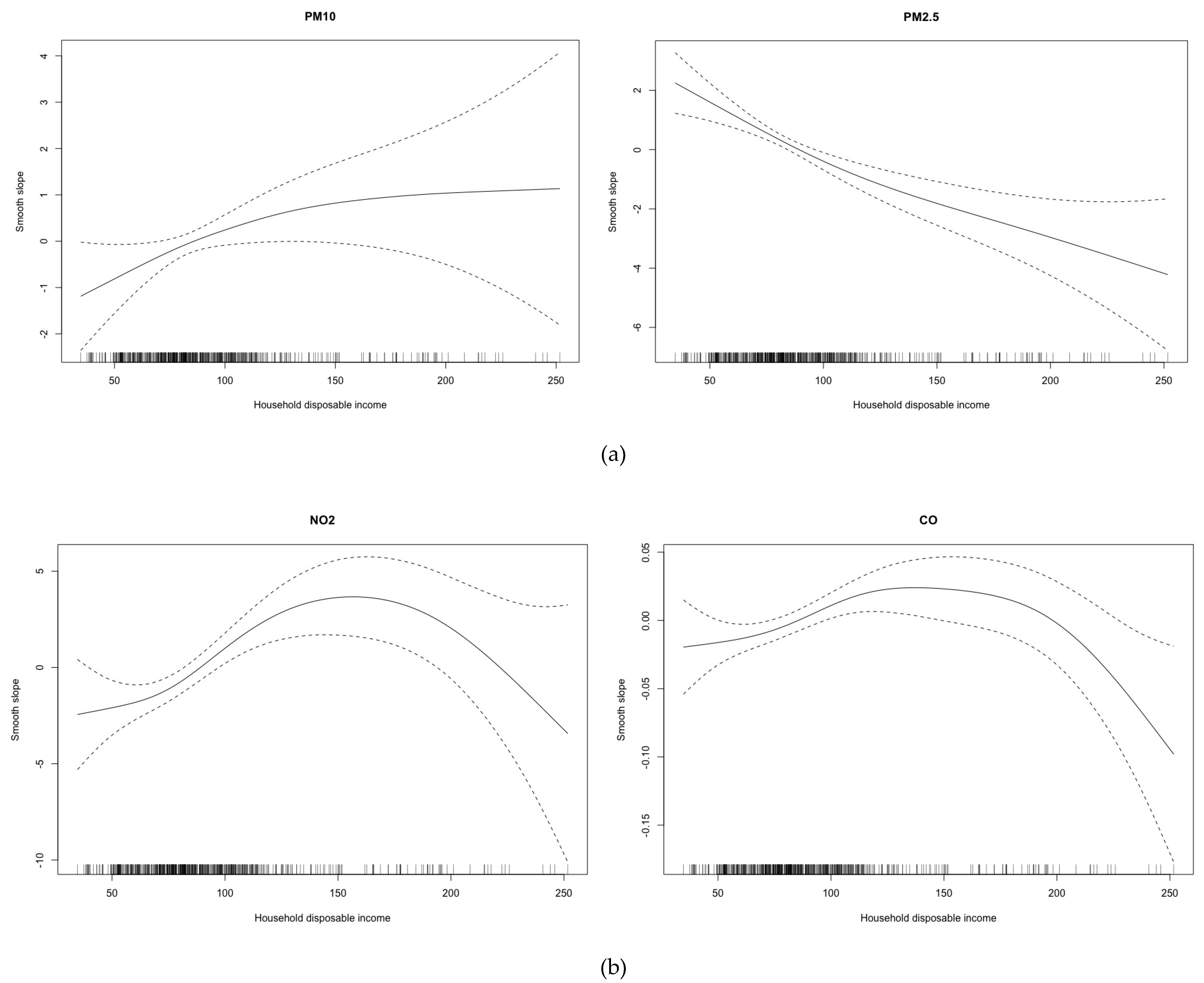
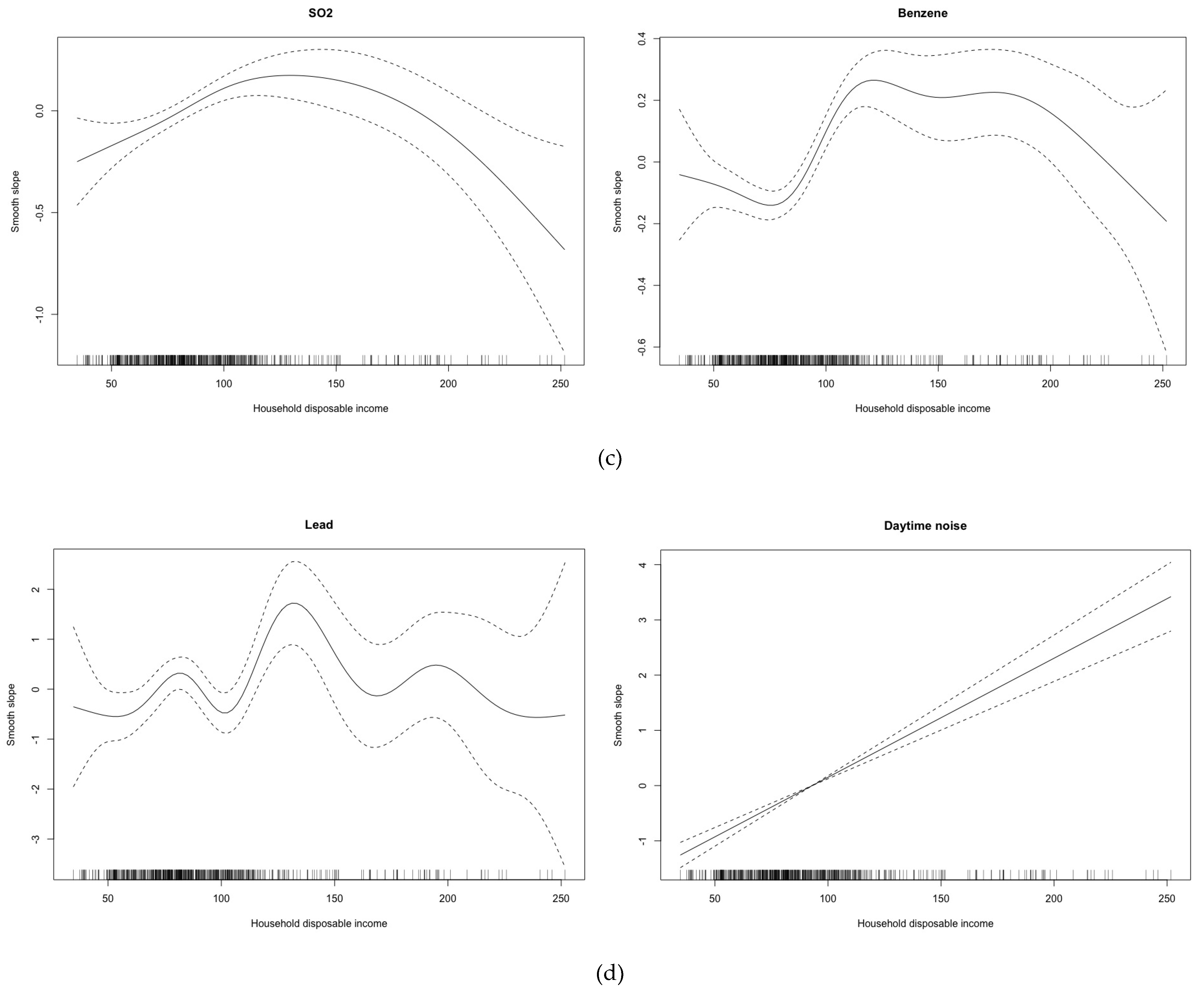
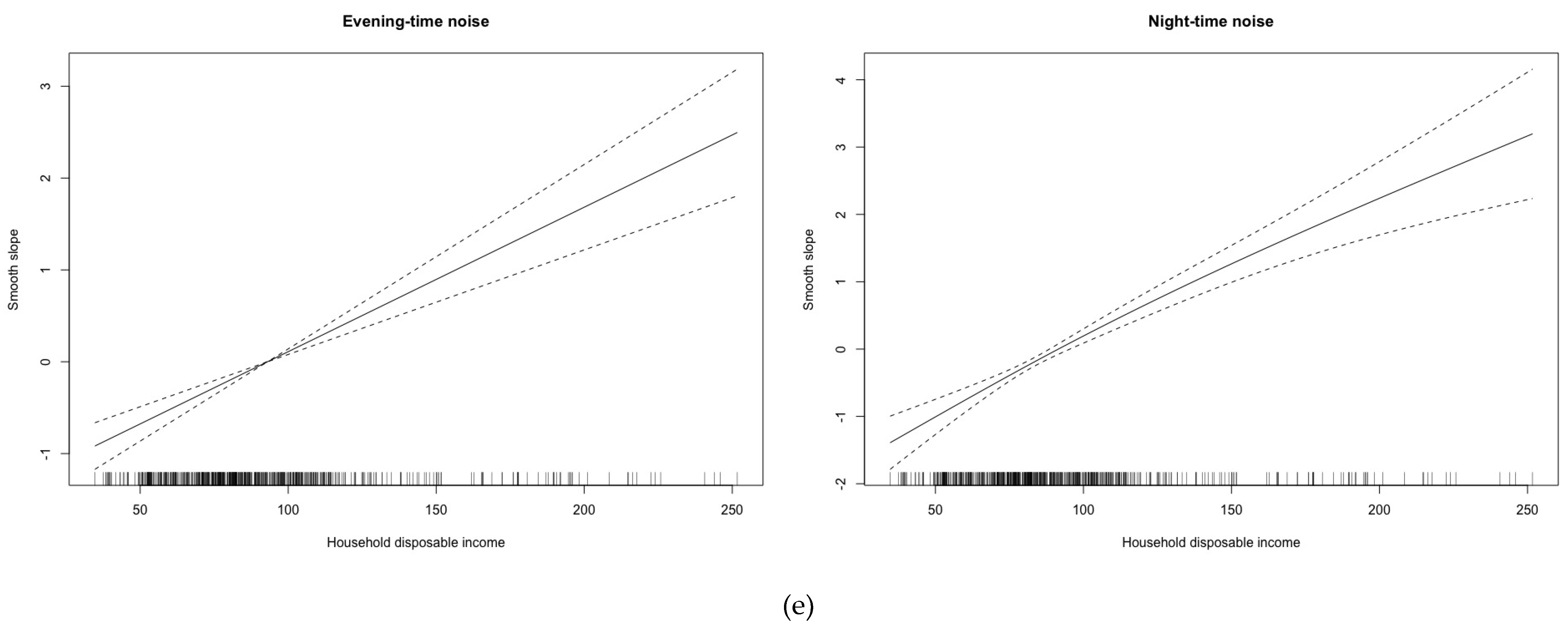
| Variable | Mean | Standard Deviation | Median | First Quartile | Third Quartile | Minimum | Maximum |
|---|---|---|---|---|---|---|---|
| Death rates (per 10,000 inhabitants) | |||||||
| Males | 97.62 | 30.31 | 93.33 | 81.60 | 107.96 | 0.00 | 326.53 |
| Females | 94.18 | 36.50 | 89.40 | 74.98 | 104.39 | 23.70 | 464.44 |
| Disposable household income (Barcelona = 100) | 93.03 | 37.62 | 84.45 | 70.05 | 104.80 | 34.70 | 251.70 |
| Foreigners from low-income countries (%) | |||||||
| Males | 5.65 | 2.50 | 4.96 | 4.11 | 6.41 | 1.62 | 21.95 |
| Females | 4.86 | 1.70 | 4.52 | 3.84 | 5.56 | 1.84 | 18.97 |
| Housing prices 1 (€/m2) | 3271.99 | 931.76 | 3174.00 | 2603.00 | 3809.00 | 1360.00 | 6298.00 |
| Land use variables 2 | |||||||
| Public services (%) 3 | 11.12 | 7.64 | 8.93 | 6.31 | 12.81 | 2.72 | 49.85 |
| Industries and infrastructures (%) 3 | 5.03 | 11.80 | 0.27 | 0.00 | 3.18 | 0.00 | 70.21 |
| Roads (%) 3 | 27.36 | 8.00 | 28.93 | 21.85 | 33.77 | 5.43 | 39.13 |
| Urban parks (%) 3 | 14.93 | 10.96 | 12.26 | 7.13 | 20.49 | 0.97 | 47.75 |
| Forest parks (%) 3 | 6.29 | 17.27 | 0.00 | 0.00 | 0.00 | 00.00 | 82.60 |
| Density of population (inhabitants/km2) | 24,819.30 | 15,220.62 | 24,299.20 | 11,628.32 | 35,175.88 | 70.38 | 60,026.83 |
| Air Pollutants 2 | Environmental Noise 3 | |||||||||
|---|---|---|---|---|---|---|---|---|---|---|
| PM10 4 | PM2.5 4 | NO2 4 | SO2 4 | CO 5 | Benzene 4 | Lead 6 | Daytime 7 | Evening-Time 7 | Night-Time 7 | |
| N 8 | 11 | 9 | 8 | 8 | 8 | 6 | 9 | 16,742 | 16,742 | 16,742 |
| Mean | 32.50 | 17.11 | 44.42 | 2.80 | 0.41 | 1.74 | 13.20 | 62.12 | 60.58 | 54.57 |
| Standard deviation | 8.693 | 2.855 | 11.473 | 0.992 | 0.1285 | 0.889 | 3.194 | 7.518 | 7.466 | 8.028 |
| Minimum | 19.00 | 12.00 | 27.00 | 1.00 | 0.20 | 0.70 | 10.30 | 0.00 | 0.00 | 0.00 |
| Maximum | 62.00 | 24.00 | 74.00 | 5.00 | 0.70 | 3.40 | 32.00 | 79.00 | 77.00 | 73.00 |
| Percentiles | ||||||||||
| 25 (1st quartile) | 26.25 | 15.00 | 36.00 | 2.00 | 0.300 | 1.08 | 11.23 | 58.00 | 57.00 | 50.00 |
| 50 (median) | 31.00 | 17.00 | 42.00 | 3.00 | 0.400 | 1.40 | 12.30 | 63.00 | 62.00 | 56.00 |
| 75 (3rd quartile) | 36.75 | 19.00 | 51.75 | 3.75 | 0.500 | 2.73 | 14.03 | 67.00 | 66.00 | 60.25 |
| Environmental Hazard Variables | Quintiles of Disposable Household Income (Barcelona = 100) | Kruskal-Wallis H 3 | ||||
|---|---|---|---|---|---|---|
| 1st Quintile | 2nd Quintile | 3rd Quintile | 4th Quintile | 5th Quintile | p-Value | |
| 34.70–64.90 | 64.90–79.32 | 79.32–92.30 | 92.30–110.76 | 110.76–251.70 | ||
| Air pollutants 2 | ||||||
| PM10 | 35.00 (0.085) [35.03] | 34.98 (0.111) [34.97] | 34.97 (0.123) [34.92] | 34.92 (0.105) [34.91] | 35.02 (0.194) [34.98] | <0.001 |
| PM2.5 | 17.41 (0.193) [17.50] | 17.34 (0.218) [17.45] | 17.34 (0.169) [17.40] | 17.33 (0.118) [17.34] | 17.22 (0.121) [17.20] | <0.001 |
| NO2 | 48.38 (0.568) [48.61] | 48.15 (0.505) [48.37] | 48.16 (0.330) [48.24] | 48.13 (0.325) [48.13] | 48.09 (0.309) [48.12] | <0.001 |
| SO2 | 4.14 (3.828) [2.77] | 3.87 (3.350) [2.83] | 3.62 (2.796) [2.57] | 5.05 (3.349) [4.61] | 3.89 (2.656) [3.64] | 0.006 |
| CO | 0.42 (0.024) [0.41] | 0.44 (0.032) [0.42] | 0.44 (0.030) [0.43] | 0.44 (0.023) [0.43] | 0.45 (0.027) [0.44] | <0.001 |
| Benzene | 2.58 (0.564) [2.71] | 2.43 (0.427) [2.56] | 2.35 (0.425) [2.38] | 2.17 (0.498) [2.23] | 2.29 (0.534) [2.45] | <0.001 |
| Lead | 13.38 (0.169) [13.31] | 13.42 (0.217) [13.34] | 13.37 (0.177) [13.51] | 13.42 (0.162) [13.40] | 13.32 (0.194) [13.34] | 0.001 |
| Environmental noise 2 | ||||||
| Daytime | 63.33 (1.731) [63.56] | 64.07 (1.559) [63.75] | 63.84 (1.786) [63.65] | 64.86 (1.863) [65.45] | 65.71 (1.951) [66.07] | <0.001 |
| Evening-time | 61.08 (1.852) [61.34] | 61.57 (1.693) [61.94] | 61.23 (1.978) [61.32] | 62.33 (2.092) [62.33] | 62.74 (2.101) [63.29] | <0.001 |
| Night-time | 54.52 (2.148) [54.55] | 55.42 (1.915) [54.94] | 55.13 (2.130) [55.15] | 56.29 (2.160) [56.37] | 57.01 (2.239) [57.62] | <0.001 |
| Title | Male | Female |
|---|---|---|
| Polluted Neighbourhood [Non-polluted] | 1.249 (1.019–1.526) | 1.399 (1.087–1.797) |
| Disposable household income [1st Quintile] | ||
| 2nd Quintile | 0.972 (0.929–1.017) | 0.987 (0.941–1.035) |
| 3rd Quintile | 0.947 (0.895–0.999) | 0.953 (0.899–0.999) |
| 4th Quintile | 0.957 (0.902–1.015) | 0.938 (0.882–0.997) |
| 5th Quintile | 0.924 (0.854–0.999) | 0.913 (0.843–0.989) |
| Interactions with Polluted Neighbourhood | ||
| 2nd Quintile | 1.017 (0.899–1.152) | 0.973 (0.850–1.114) |
| 3rd Quintile | 0.823 (0.653–1.041) | 0.716 (0.539–1.042) |
| 4th Quintile | 0.857 (0.684–1.077) | 0.711 (0.545–1.045) |
| 5th Quintile | 0.794 (0.632–1.002) | 0.706 (0.537–0.932) |
| Air pollutants | ||
| PM10 | 1.377 (0.907–2.081) | |
| Benzene | 1.077 (1.004–1.207) | 1.117 (1.018–1.240) |
| Environmental noise | ||
| Daytime | 1.219 (0.904–1.580) | 1.044 (0.748–1.457) |
| Evening-time | 1.131 (1.014–1.261) | 1.117 (0.954–1.309) |
| Interactions with quintiles of income | ||
| Air pollutants [1st Quintile] | ||
| PM2.5-2nd Quintile | 1.253 (0.956–1.640) | |
| NO2-5th Quintile | 0.918 (0.795–1.059) | |
| CO-5th Quintile | 0.143 (0.007–2.835) | |
| SO2-5th Quintile | 0.987 (0.972–1.003) | |
| Benzene-5th Quintile | 0.850 (0.704–0.989) | 0.898 (0.705–0.993) |
| Environmental noise [1st Quintile] | ||
| Evening-time noise | ||
| 2nd Quintile | 0.944 (0.887–0.999) | 0.950 (0.874–1.033) |
| 5th Quintile | 1.125 (1.008–1.269) | 1.010 (0.871–1.148) |
| Night-time noise-5th Quintile | 0.840 (0.668–1.055) |
© 2019 by the authors. Licensee MDPI, Basel, Switzerland. This article is an open access article distributed under the terms and conditions of the Creative Commons Attribution (CC BY) license (http://creativecommons.org/licenses/by/4.0/).
Share and Cite
Saez, M.; López-Casasnovas, G. Assessing the Effects on Health Inequalities of Differential Exposure and Differential Susceptibility of Air Pollution and Environmental Noise in Barcelona, 2007–2014. Int. J. Environ. Res. Public Health 2019, 16, 3470. https://doi.org/10.3390/ijerph16183470
Saez M, López-Casasnovas G. Assessing the Effects on Health Inequalities of Differential Exposure and Differential Susceptibility of Air Pollution and Environmental Noise in Barcelona, 2007–2014. International Journal of Environmental Research and Public Health. 2019; 16(18):3470. https://doi.org/10.3390/ijerph16183470
Chicago/Turabian StyleSaez, Marc, and Guillem López-Casasnovas. 2019. "Assessing the Effects on Health Inequalities of Differential Exposure and Differential Susceptibility of Air Pollution and Environmental Noise in Barcelona, 2007–2014" International Journal of Environmental Research and Public Health 16, no. 18: 3470. https://doi.org/10.3390/ijerph16183470
APA StyleSaez, M., & López-Casasnovas, G. (2019). Assessing the Effects on Health Inequalities of Differential Exposure and Differential Susceptibility of Air Pollution and Environmental Noise in Barcelona, 2007–2014. International Journal of Environmental Research and Public Health, 16(18), 3470. https://doi.org/10.3390/ijerph16183470





